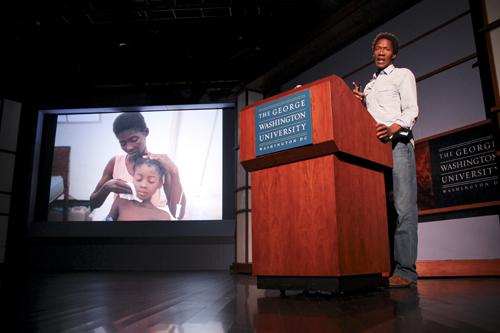
This post was written by Hatchet reporter Nicholas Rosato.
A panel of photojournalists specializing in crisis reporting reflected on the challenges of humanizing issues of international events in an event held at the Jack Morton Auditorium Monday night.
The program – sponsored by the Pulitzer Center on Crisis Reporting, the School of Media and Public Affairs and FotoDC – demonstrated the power of photographs to raise awareness about environmental, social and political crises across Africa, Asia, Haiti and other regions.
“Trying to humanize these events is a difficult task,” Dominic Bracco, whose pictures documented drug violence in the Mexican border town of Ciudad Juarez, said.
Covering local communities, he explained, involves being let into their lives by taking their photograph.
The panelists agreed that the ability to bring images from the field into publication relied on each photographer’s ability to illustrate the value of a narrative.
“The challenge is to translate what I find important to what others find important,” James Whitlow Delano, who covered deforestation in Malaysia, said.
After chronicling Haiti’s post-earthquake poverty, Andre Lambertson said public reaction to an individual’s work is another factor that crisis reporters need to consider.
“There is a sense of feeling powerless,” Lambertson said.
Though “we are all bombarded with images of death, disease and destruction,” David Rochkind, who analyzed the effects of Tuberculosis in the Third World, said “the images have to move beyond pure emotion” to make a story stick.
Richard Mosse made his photos exploring Eastern Congo unique by using old U.S. military technology that turned the landscapes bubblegum pink instead of the usual “black and grey approach.”
“It is very difficult to put complex issues in front of a lens,” Mosse said.
The event coincided with the annual photography festival FotoWeek D.C., which encourages professional and aspiring photographers to display their craft in a number of venues throughout the city.




